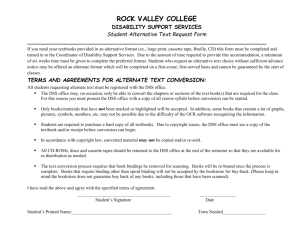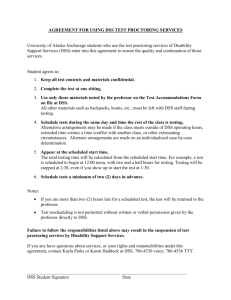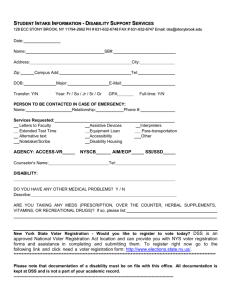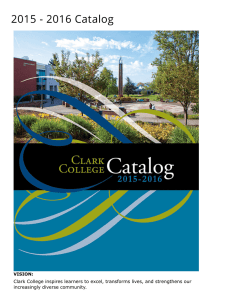DISABILITY CODING GUIDELINES INTENT
advertisement
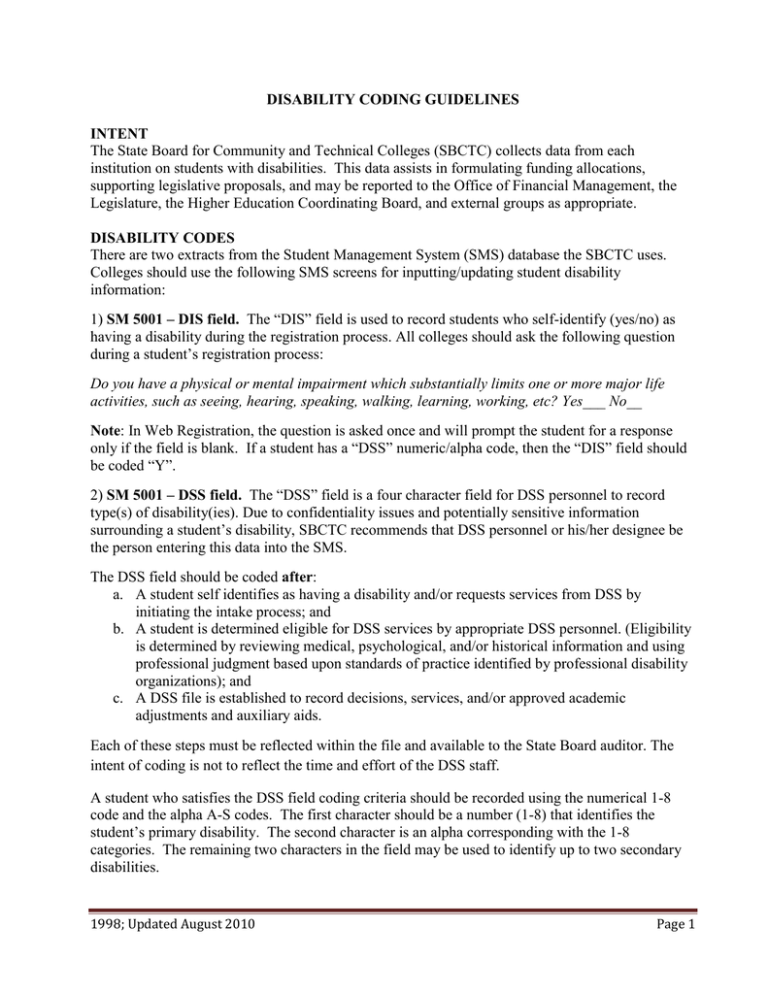
DISABILITY CODING GUIDELINES INTENT The State Board for Community and Technical Colleges (SBCTC) collects data from each institution on students with disabilities. This data assists in formulating funding allocations, supporting legislative proposals, and may be reported to the Office of Financial Management, the Legislature, the Higher Education Coordinating Board, and external groups as appropriate. DISABILITY CODES There are two extracts from the Student Management System (SMS) database the SBCTC uses. Colleges should use the following SMS screens for inputting/updating student disability information: 1) SM 5001 – DIS field. The “DIS” field is used to record students who self-identify (yes/no) as having a disability during the registration process. All colleges should ask the following question during a student’s registration process: Do you have a physical or mental impairment which substantially limits one or more major life activities, such as seeing, hearing, speaking, walking, learning, working, etc? Yes___ No__ Note: In Web Registration, the question is asked once and will prompt the student for a response only if the field is blank. If a student has a “DSS” numeric/alpha code, then the “DIS” field should be coded “Y”. 2) SM 5001 – DSS field. The “DSS” field is a four character field for DSS personnel to record type(s) of disability(ies). Due to confidentiality issues and potentially sensitive information surrounding a student’s disability, SBCTC recommends that DSS personnel or his/her designee be the person entering this data into the SMS. The DSS field should be coded after: a. A student self identifies as having a disability and/or requests services from DSS by initiating the intake process; and b. A student is determined eligible for DSS services by appropriate DSS personnel. (Eligibility is determined by reviewing medical, psychological, and/or historical information and using professional judgment based upon standards of practice identified by professional disability organizations); and c. A DSS file is established to record decisions, services, and/or approved academic adjustments and auxiliary aids. Each of these steps must be reflected within the file and available to the State Board auditor. The intent of coding is not to reflect the time and effort of the DSS staff. A student who satisfies the DSS field coding criteria should be recorded using the numerical 1-8 code and the alpha A-S codes. The first character should be a number (1-8) that identifies the student’s primary disability. The second character is an alpha corresponding with the 1-8 categories. The remaining two characters in the field may be used to identify up to two secondary disabilities. 1998; Updated August 2010 Page 1 For example, a student whose primary disability is blindness, also has secondary disabilities of Attention Deficit Disorder (ADD) and diabetes should be coded as 5 I G N. VALID DSS CODES CATEGORIES 1 DEAF/HEARING 2 MOBILITY COLLAPSIBLE SUB-GROUPS with some EXAMPLES A Deaf (Documented profound hearing loss making everyday auditory communication impossible, requiring the need for interpreter and other possible service.) B Severe to moderate hearing loss (Documented loss which causes interference with normal auditory processing and may require adaptive equipment, note taker, etc., but not interpreter.) C Limited Gait or Range of Motion (Amputee, Hemiplegic, Brace/crutch user, Arthritis, etc.) Paraplegic (Wheelchair user, Spinal Cord Injury or other condition limiting use of lower extremities, etc.) Quadriplegic (Wheelchair user, Spinal Cord Injury or other condition limiting use of upper & lower extremities) D E 3 SPEECH/LANGUAGE F Speech or Language Disorder (Stutterer, Laryngectomy, Articulation or Fluency Disorder, Aphasia, Dysphasia, Dysarthria, Dyspraxia, etc.) 4 LEARNING DISABILITY G Attention Deficit Disorder (Medical/psychological documentation of ADD) H Dyslexia or Processing Deficits (Appropriate documentation for specific learning disability) 5 BLIND/VISUAL I Blind (No light perception or by definition of legal blindness) J Visual Disorders other than Blind (Nystagmus, Strabismus, Cataracts, etc.) K Cancer (Hodgkin's, Leukemia, Carcinoma, etc.) L Cardiovascular/Pulmonary (Cardiac Diseases, Hypertension, Atherclerosis, Thrombosis, Chronic Bronchitis, Asthma, Emphysema, etc.) 6 CHRONIC/ACUTE HEALTH M Orthopedic Conditions (Arthritis, Osteoporosis, Ankylosing Spondylitis, Degenerative Disk, Fractures, etc.) N 1998; Updated August 2010 Organ, Blood, Gastrointestinal, Connective Tissue, Immune Disorders (Renal Disease, Diabetes, Lupus, CFS, HIV/AIDS, Anemia, Sickle Cell, Crohn's Disease, Fibromyalgia, Diverticulosis, Allergies, etc.) Page 2 7 NEUROLOGICAL/ NERVOUS SYSTEM 8 PSYCHOLOGICAL/ EMOTIONAL O Motor Neuron (Cerebral Palsy, Seizures, Multiple or Amyotrophic Sclerosis, Tourette Syndrome, Parkinson's, Migraine, Polio, Peripheral Neuropathies, Muscular Dystrophy, etc.) P Acquired Brain Injury (Head injury/trauma to brain from external or internal forces such as: Concussion, Contusion, CVA, Aneurysm, Meningitis, Abscess, Brain Tumor, etc.) Q Developmental Disability R Mental Disorders (Disorders diagnosed according to DSM-IV classifications such as: Schizophrenia, Bi-Polar, Personality Disorders, Depression, Anxiety, Eating Disorders, PTSD, etc.) S Autism Spectrum Disorders (Autism, Asperger's Syndrome, Pervasive Developmental Disorders, etc.) History: The “HEALTH_LIM” field was added in 1997-98 and was edited to “DSS” in Winter 1998. The “S – Autism Spectrum Disorders” subcategory was added in Winter 2010. Each college’s MIS coordinator can determine the date the college will run its final quarterly reports for the SBCTC as the DIS and DSS codes must be entered before MIS final reports are run. The MIS Reporting Calendar is posted on the SBCTC’s website. SBCTC Invalid Health Limitation Codes Audit Report Each quarter, Disability Support Services Council (DSSC) Representatives are emailed a copy of the respective college’s Invalid Health Limitation Codes Report. To avoid coding errors, the information listed below should be followed: The DIS field should either contain a “Y”, “N”, or remain blank. If the DIS column is a “Y”, then the second column may contain a 1-8/A-S disability category code. If the DIS column is an “N” or blank, the second column should remain blank. Example: STATE BOARD FOR COMMUNITY AND TECHNICAL COLLEGES INVALID HEALTH LIMITATION CODES QUARTER/YEAR COLLEGE SID DISABILITY (DIS) ANDERSON COLLEGE ANDERSON COLLEGE ANDERSON COLLEGE 123456789 987654321 246810121 N N Y 1998; Updated August 2010 HEALTH_LIM (DSS) -O C Page 3

